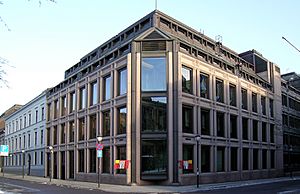Norges Bank facts for kids
 |
|

Headquarters at Bankplassen 2
|
|
| Headquarters | Oslo |
|---|---|
| Established | 14 June 1816 |
| Ownership | 100% state ownership |
| Governor | Ida Wolden Bache |
| Central bank of | Norway |
| Currency | Norwegian krone NOK (ISO 4217) |
| Reserves | 750 billion NOK (2024) |
| Bank rate | 5.50% |
| Interest rate target | 4.50% |
| Interest on reserves | 3.50% |
Norges Bank, also known as the Bank of Norway, is like the main bank for the country of Norway. It has two very important jobs. First, it manages Norway's big savings account, called the Government Pension Fund. This fund is the largest of its kind in the world! Second, Norges Bank also looks after Norway's foreign money, called foreign exchange reserves.

Contents
The Story of Norges Bank
The history of Norway's central bank began a long time ago.
How Norges Bank Started
Norges Bank was created in 1816. This was two years after Norway separated from Denmark and joined with Sweden. The Norwegian parliament, called the Storting, passed a law on June 14 to start the bank. At that time, the main money unit was called the "speciedaler." It was divided into smaller parts like "skillings" and "ort."
Changing to the Krone
In 1875, a new law changed Norway's money. The "daler" and "skilling" names were stopped. Instead, the new money unit became the "krone," which was divided into 100 "øre." This change happened because Norway was getting ready to join the Scandinavian Monetary Union. This union was an agreement between Denmark, Sweden, and Norway to use a common coin based on gold. This meant that coins from these other countries could be used in Norway just like Norwegian coins. The union worked until 1914, but it was not officially ended until 1972.
Moving to Oslo
On January 1, 1897, the main office of Norges Bank moved. It moved from Trondheim to Kristiania, which is now known as Oslo. In 1906, a new main building for the bank opened in Oslo. About 80 people worked there, including those who printed banknotes.
Norges Bank During World War II
During the Second World War, Norges Bank's main office moved temporarily to London in 1940. The Norwegian government, which was in exile, set up a new board for the bank there. The bank's gold was moved safely out of Norway to London, and then to New York and Ottawa. This gold and other money reserves were controlled by the London board.
At the same time, the bank kept working in Norway under the control of the Nazis. After the war, the London board stepped down. An investigation found that the bank's leaders in Oslo had acted correctly towards the Nazi authorities. In 1962, the Royal Mint, which makes coins, became part of Norges Bank.
Recent Investments
In March 2025, Norges Bank Investment Management announced a big purchase. It bought a 49% share in two offshore wind farms. These wind farms are being built in Denmark and Germany. The deal was worth 1.4 billion euros (about 1.5 billion US dollars). These wind projects are expected to produce enough electricity to power over 2.6 million homes. Norges Bank's investment helps reduce the costs for the company building the wind farms, while that company still manages the building and running of them.
Norges Bank Investment Management (NBIM)
Norges Bank Investment Management, or NBIM, is a special part of Norges Bank. Its main job is to manage the Government Pension Fund - Global. NBIM also manages Norges Bank's foreign exchange reserves. NBIM invests this money in different ways. They buy parts of companies (called equities) and also invest in things like fixed income and money market instruments.
Leaders of Norges Bank
Here is a list of the people who have led Norges Bank over the years. In 1892, a law made the board's chairman a permanent position. In 1985, this leader was given the title "Governor of the Central Bank."
- Karl Gether Bomhoff (1893–1920)
- Nicolai Rygg (1920–1946)
- Arnold C. Ræstad (head of the London branch 1940–1945)
- Gunnar Jahn (1946–1954)
- Erik Brofoss (1954–1970)
- Knut Getz Wold (1970–1985)
- Hermod Skånland (1985–1993)
- Torstein Moland (1994–1995)
- Kjell Storvik (1996–1998)
- Svein Gjedrem (1999–2010)
- Øystein Olsen (2011–2022)
- Ida Wolden Bache (2022–present)
London Branch Leader
- Arnold C. Ræstad (head of the London branch 1940–1945)
See also
 In Spanish: Banco de Noruega para niños
In Spanish: Banco de Noruega para niños
- Economy of Norway
- Norwegian krone
- Gold reserves of Norway
- List of central banks

